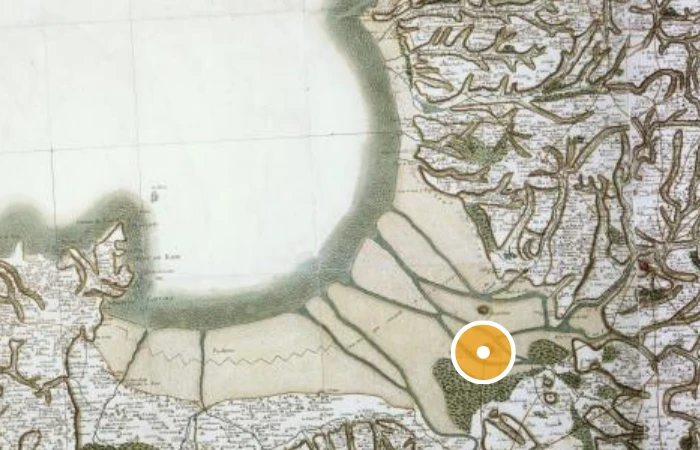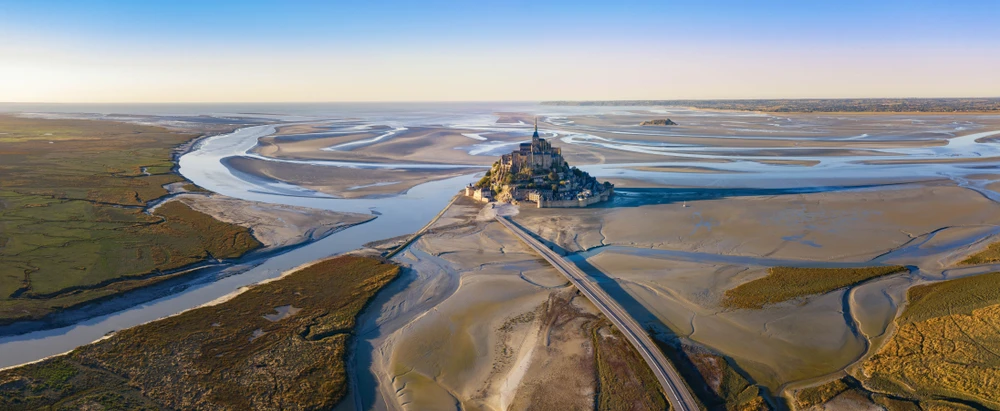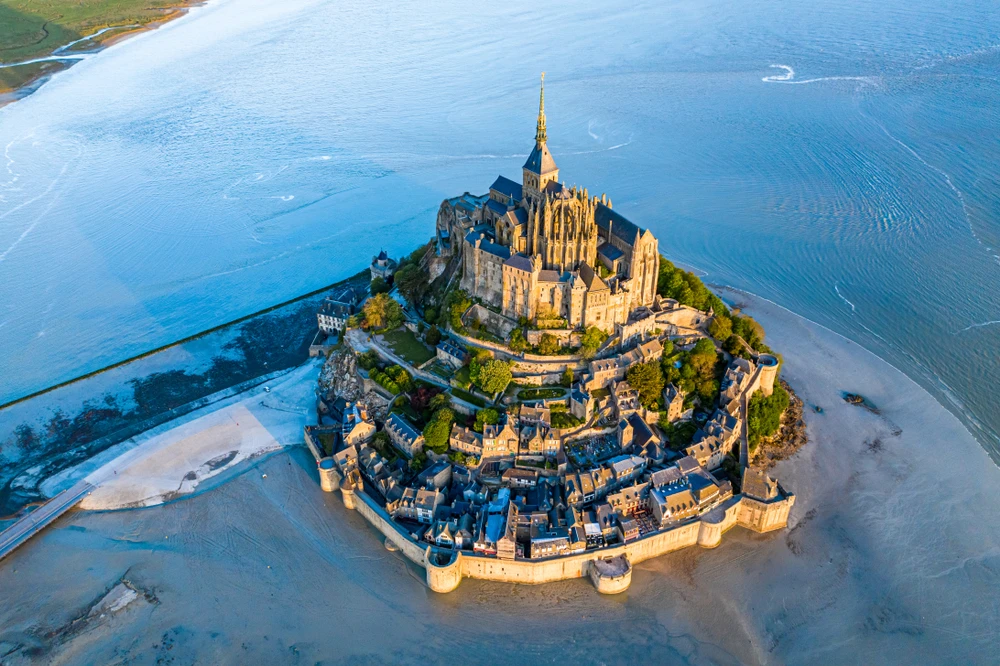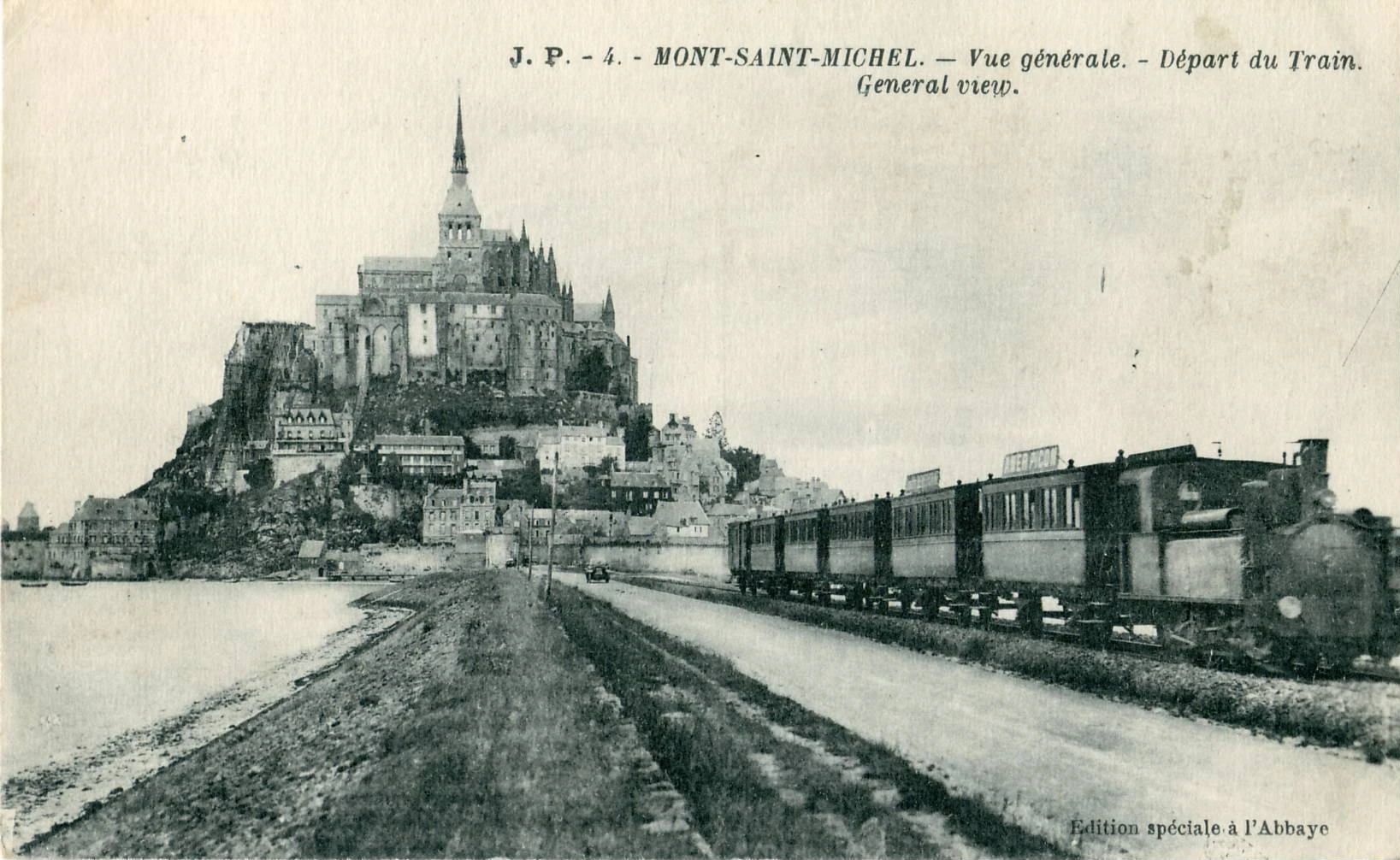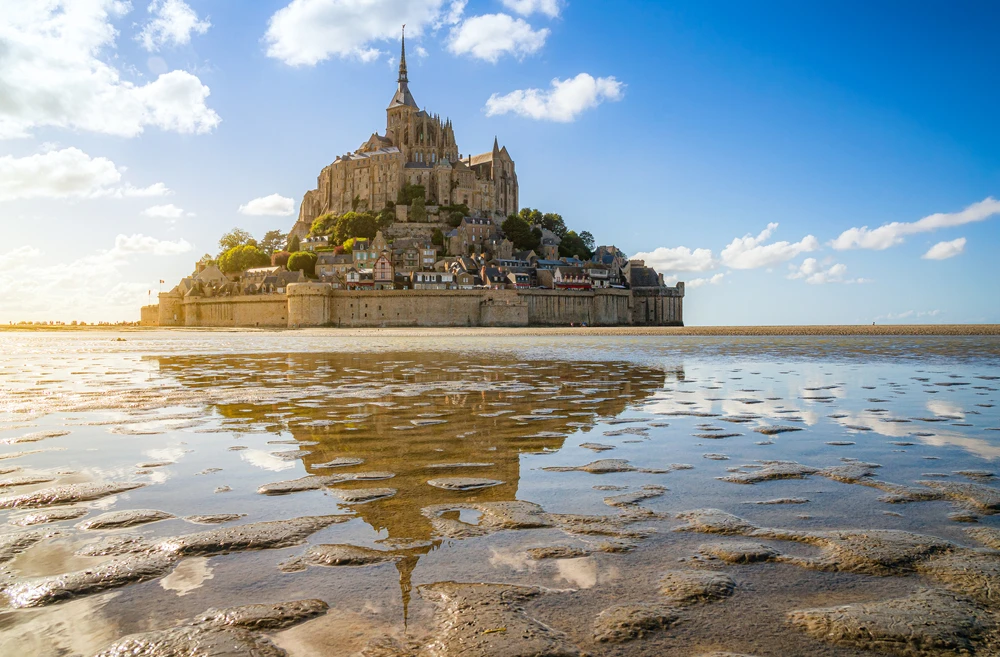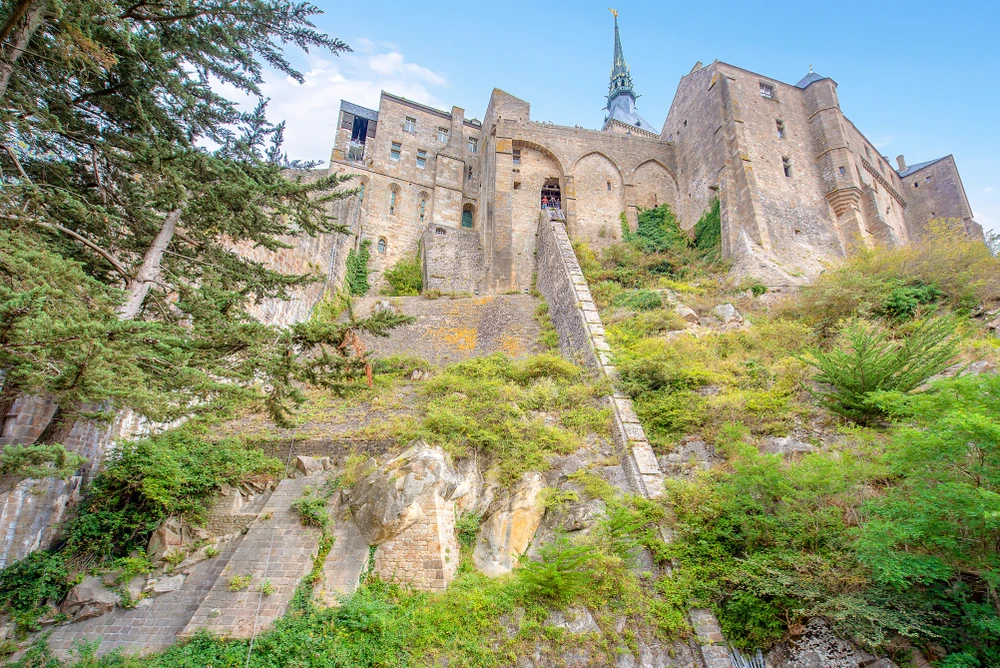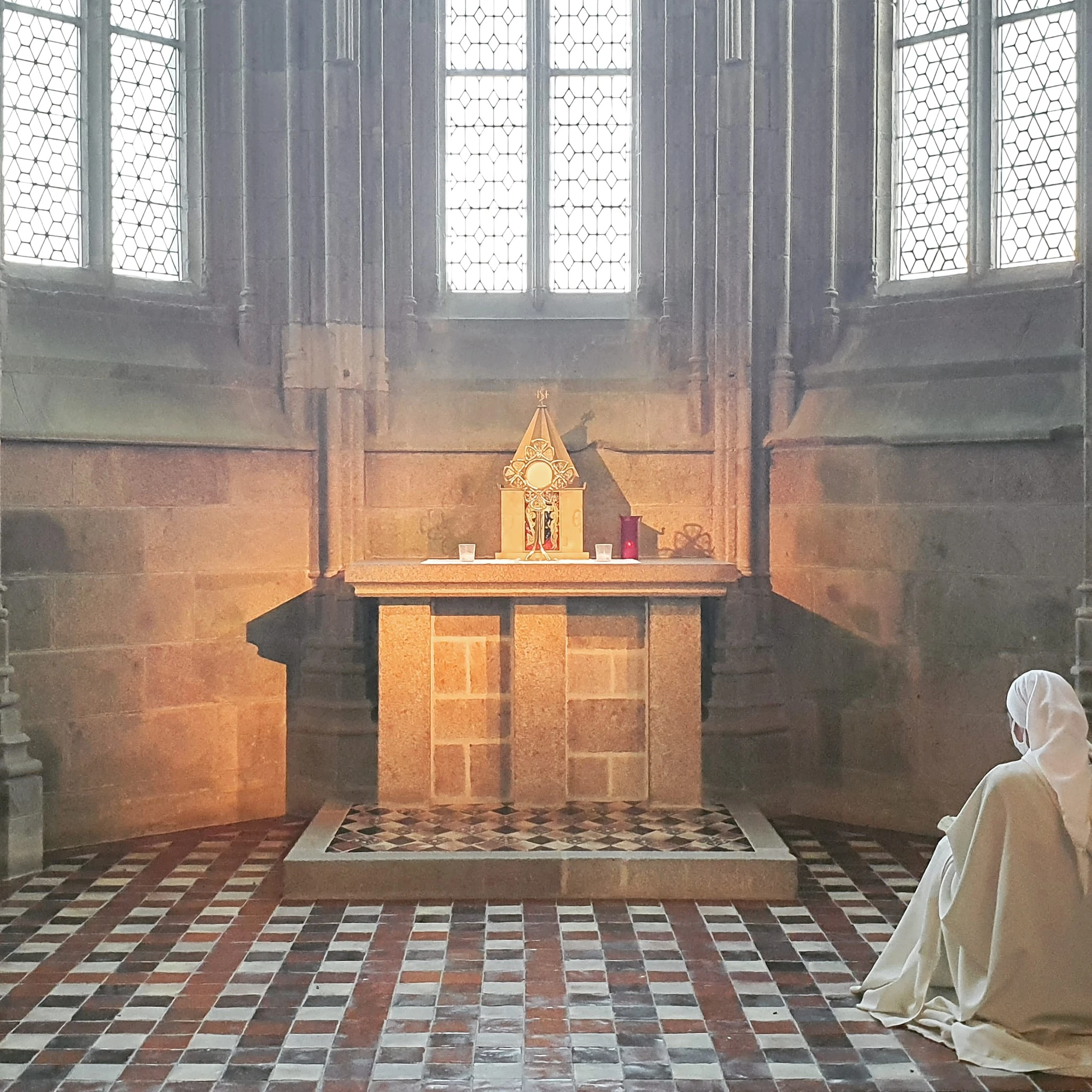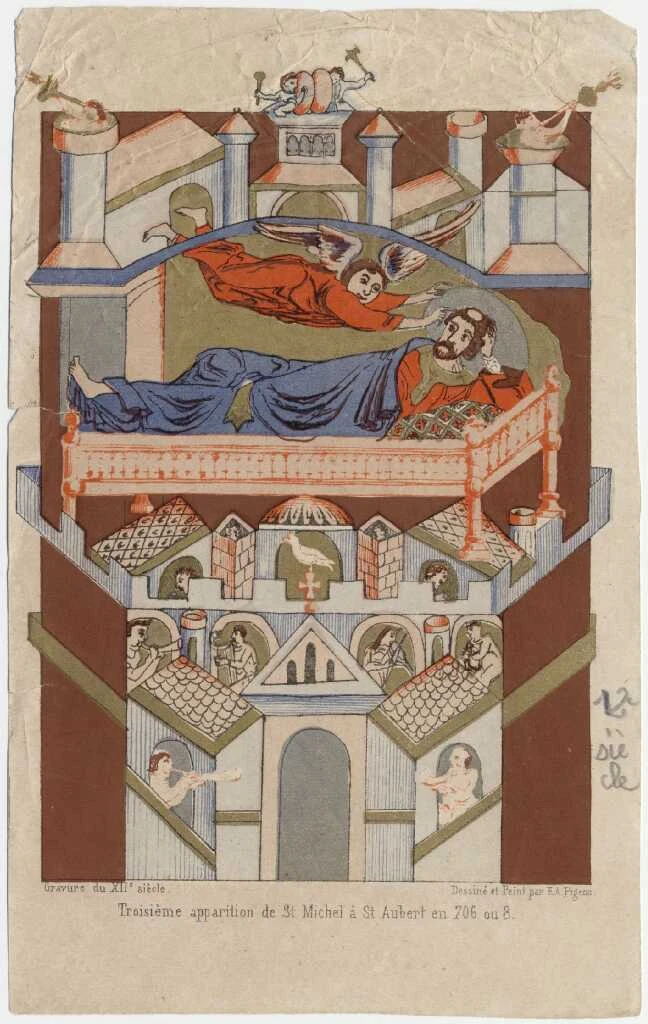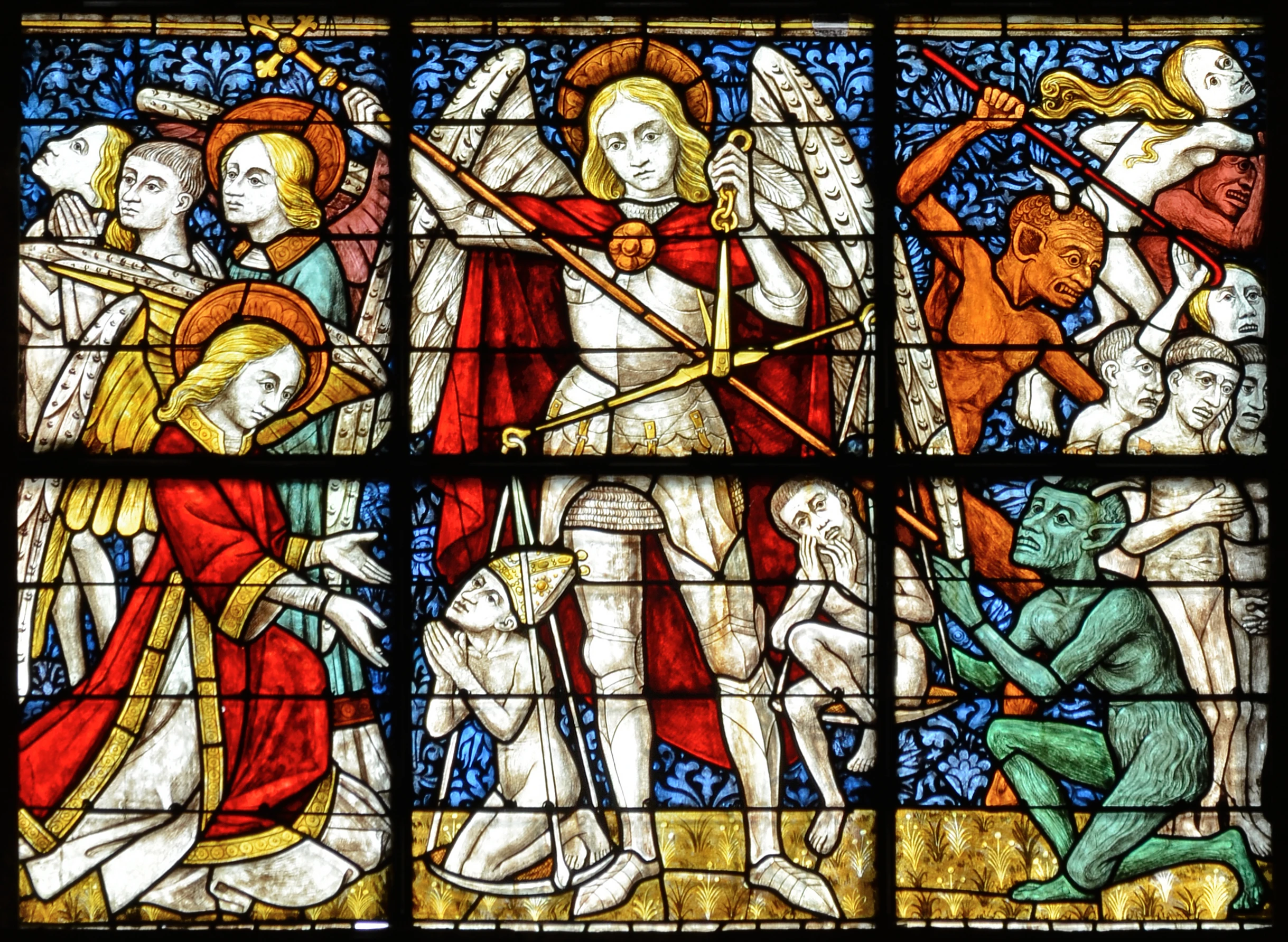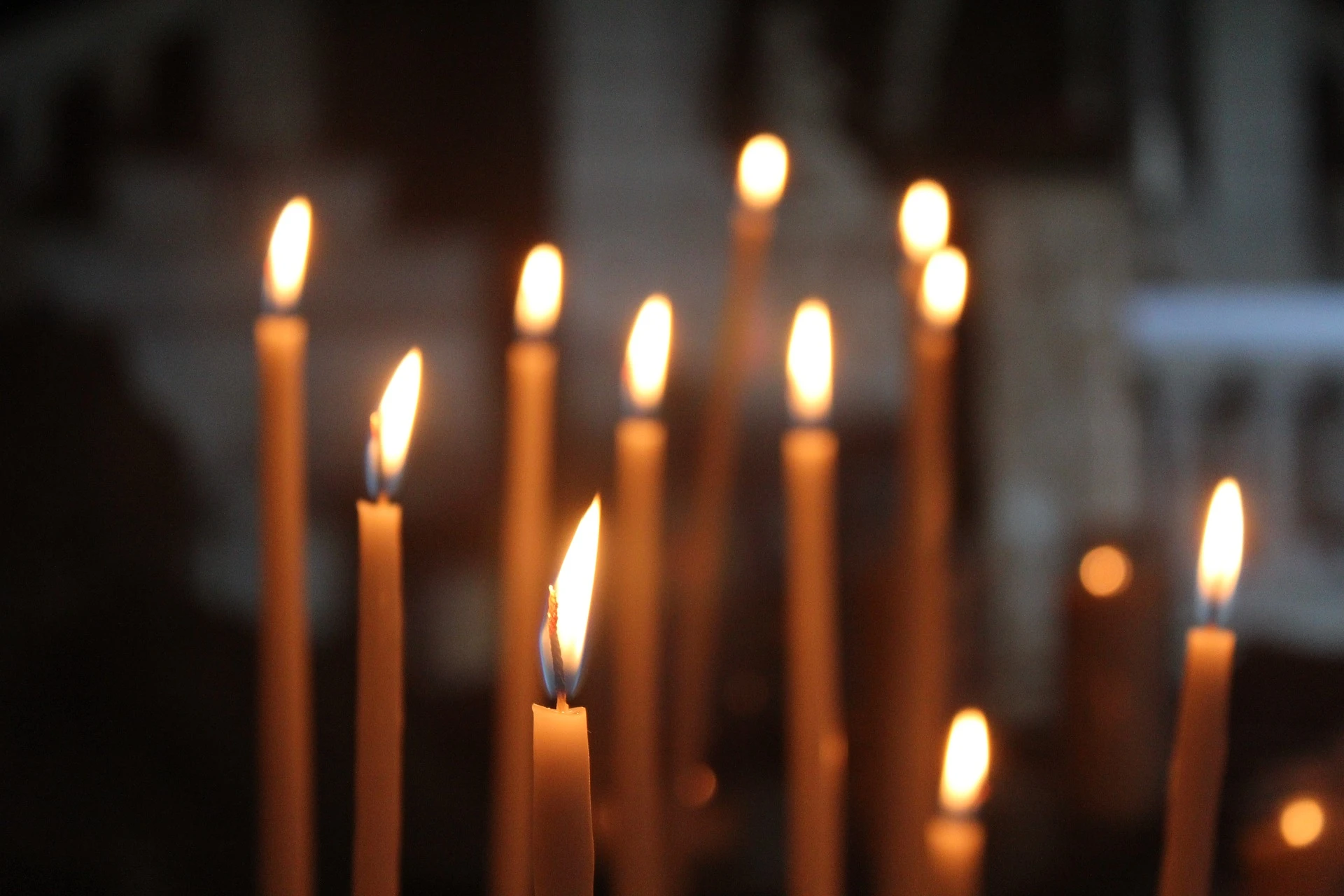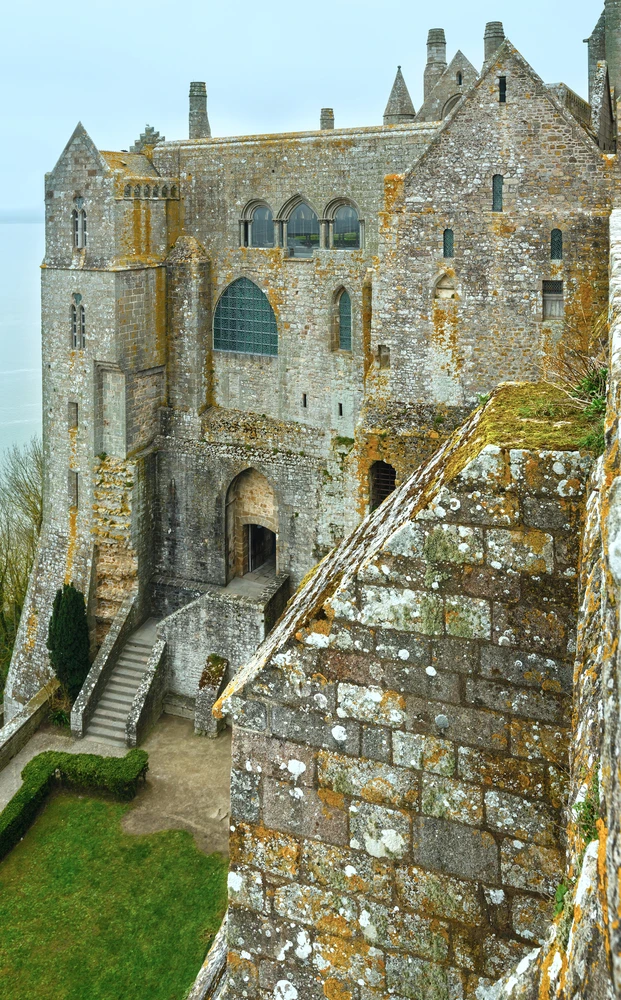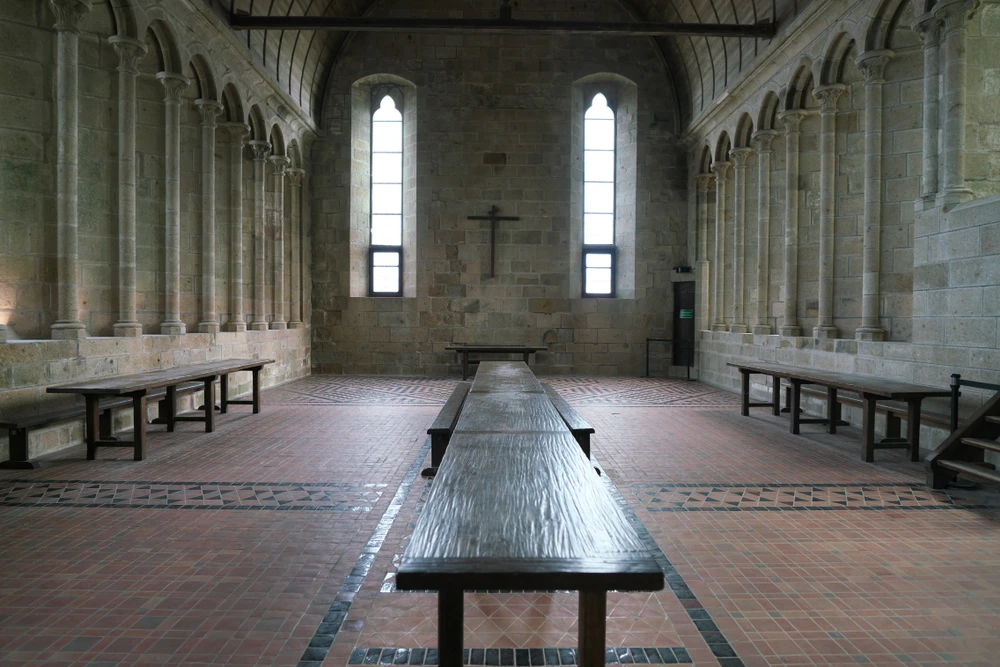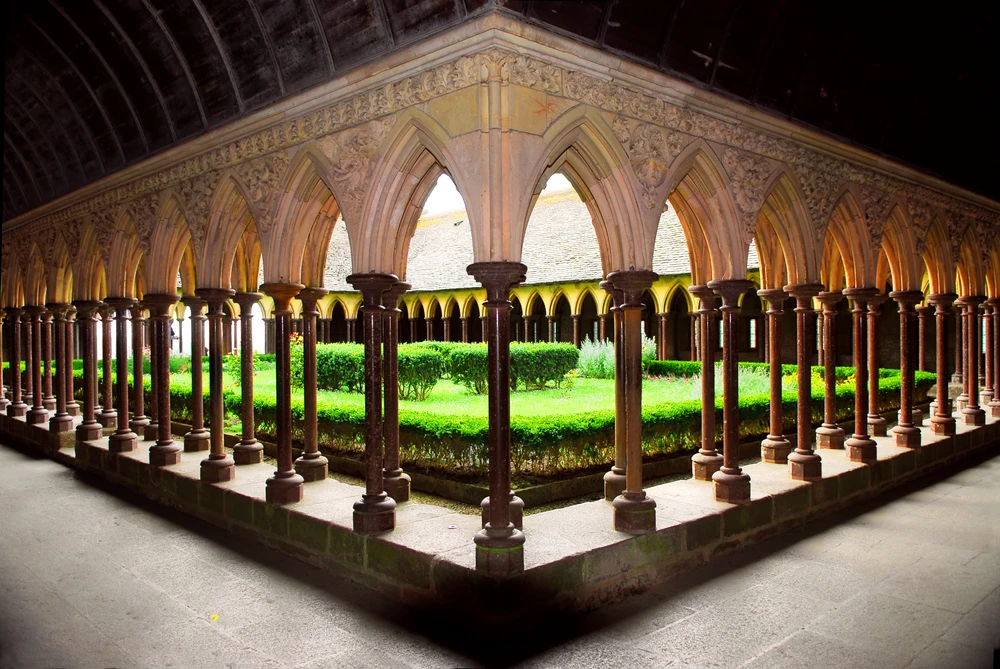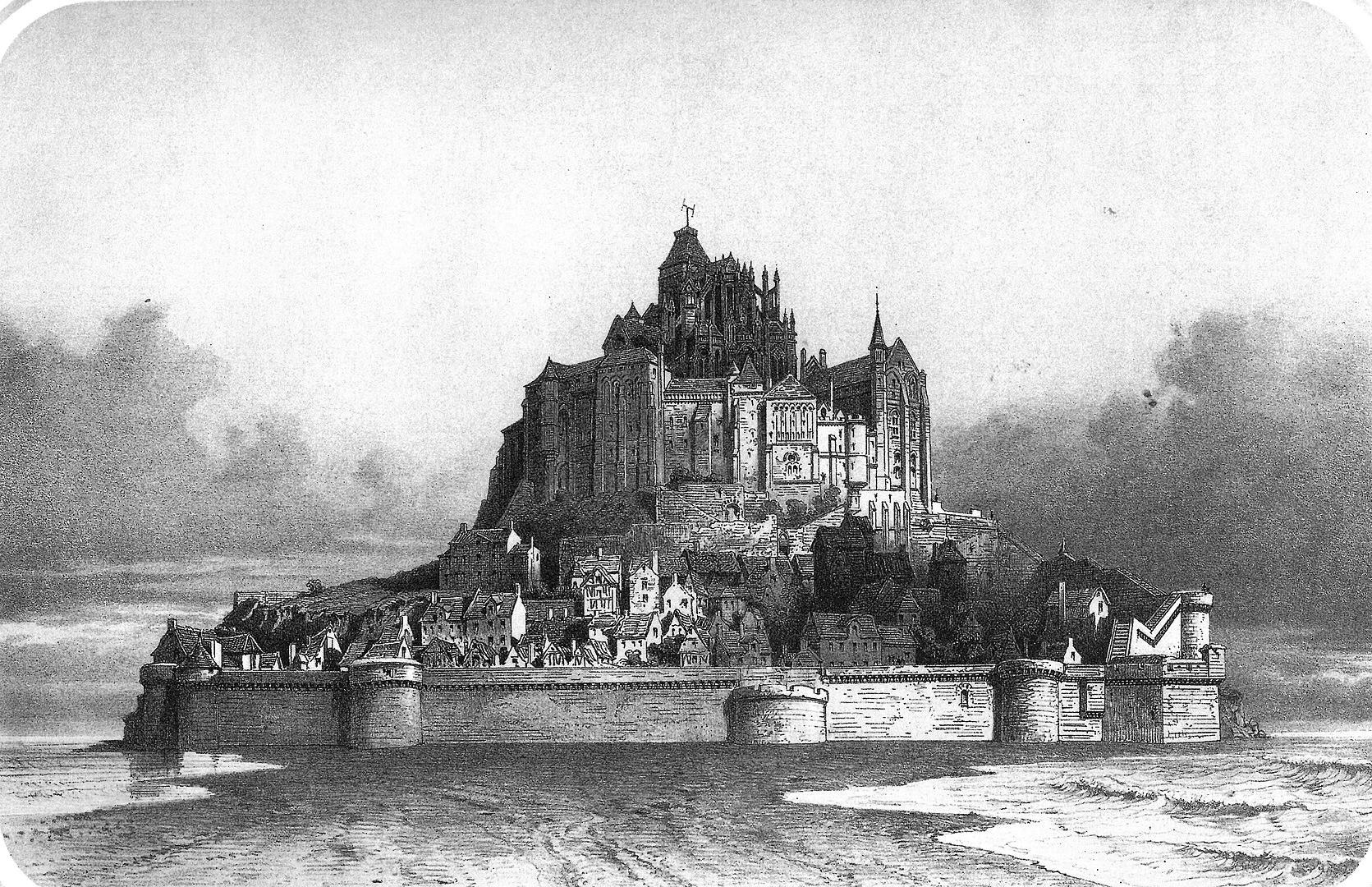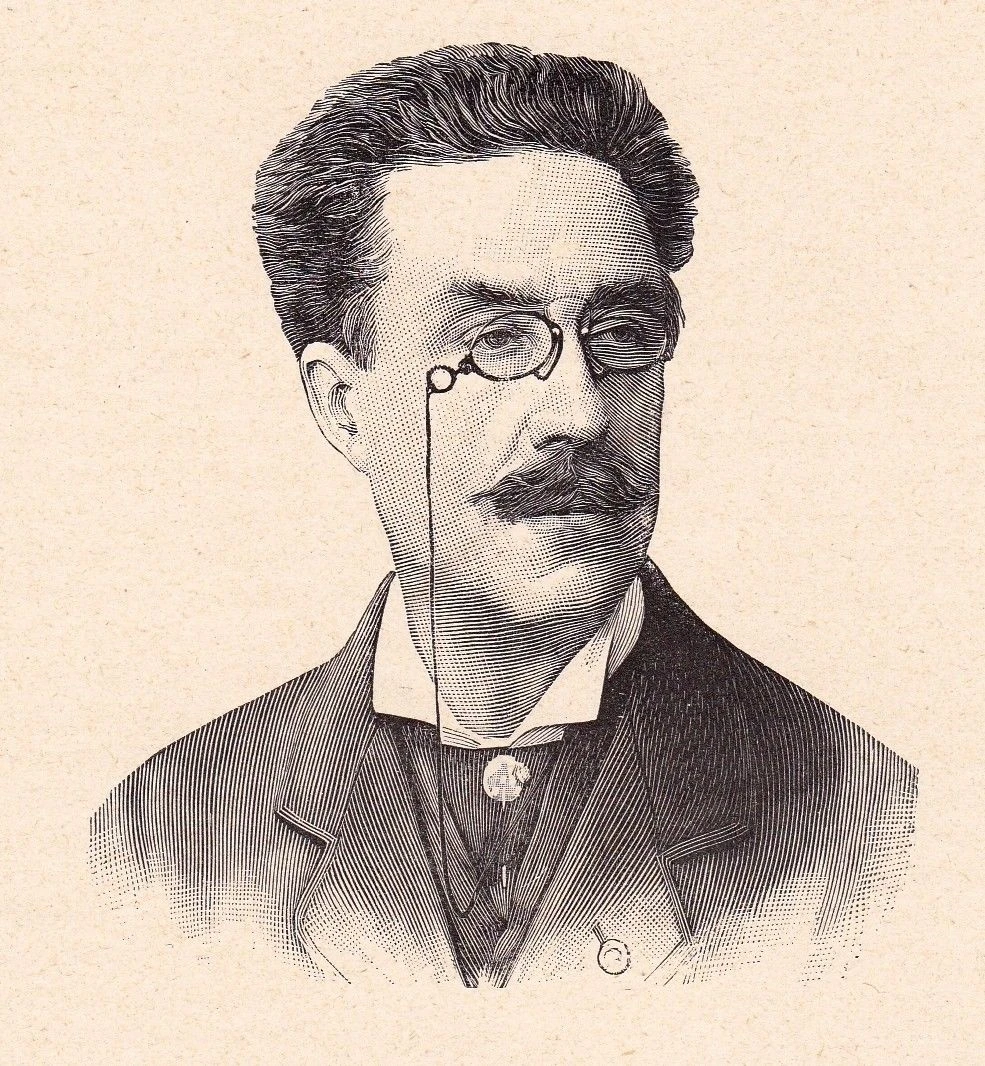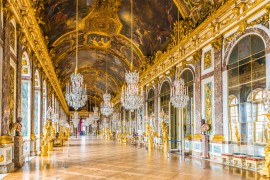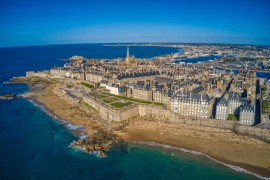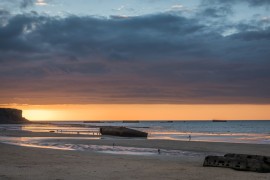What is the Mont Saint Michel?
An inhabited rock in an immense bay
The Mont-Saint-Michel is the most visited site in Normandy with an average of 2,500,000 visitors each year. It is one of the top 10 most visited French monuments. It is a commune, populated by 27 inhabitants called the Montois, and directed by a mayor. The surface of the commune is 4 km2, a pebble in the middle of a huge bay, the bay of Mont-Saint-Michel, which is 500 km2. This bay is the one where we find the biggest tides in Europe, with 15 meters of tidal range (difference between high and low water). It is said that the sea returns at the speed of a galloping horse and has surprised many unwary walkers or pilgrims.
The Mont Saint Michel represented in the middle of the Bay on the Cassini map (17th century). On the left is Saint Malo, on the right is Granville.
The sea does not always surround the mount which, most of the time, emerges from sandbanks (it is besides what makes its charm, it shines, it is rather astonishing.) It is at the time of the big tides (above coefficient 100) that the Mont-Saint-Michel becomes an island (if we exclude the footbridge which is never submerged and thus makes it rather a peninsula) Around the Mont and after the sandbanks, there are "salt meadows" where the grass grows on a ground where the sea sometimes comes. The wind and the sea make it salty. Lambs and sheep are grazed there and are known to be delicious thanks to this grass which is rare elsewhere. The island is 87 meters high at its highest level. This is quite a difference in height since, in comparison, the town hall is only 5 meters above sea level.
The Mont Saint Michel seen from the sky: we can see the bay and its sandbanks and a little further, in green, the salt meadows. On the left, the river that passes on the left is called the Couesnon and marks the border between Normandy and Brittany. The Mont, located on the right, is in Normandy. Photo chosen by monsieurdefrance.fr: Jrossphoto/Shutterstock.com
At the top an abbey
The abbey is located at the top of the island and occupies the summit. Its heart, the abbey church, is located at about the same level as the tip of the rock, hence the nickname of this abbey; "the Wonder". A nickname well deserved since the buildings are erected very high above the rock and an incredible genius was required from those who built it all several centuries ago. It belongs to the State and is managed by the Centre des Monuments Nationaux.
And at the top: Saint Michel archangel.
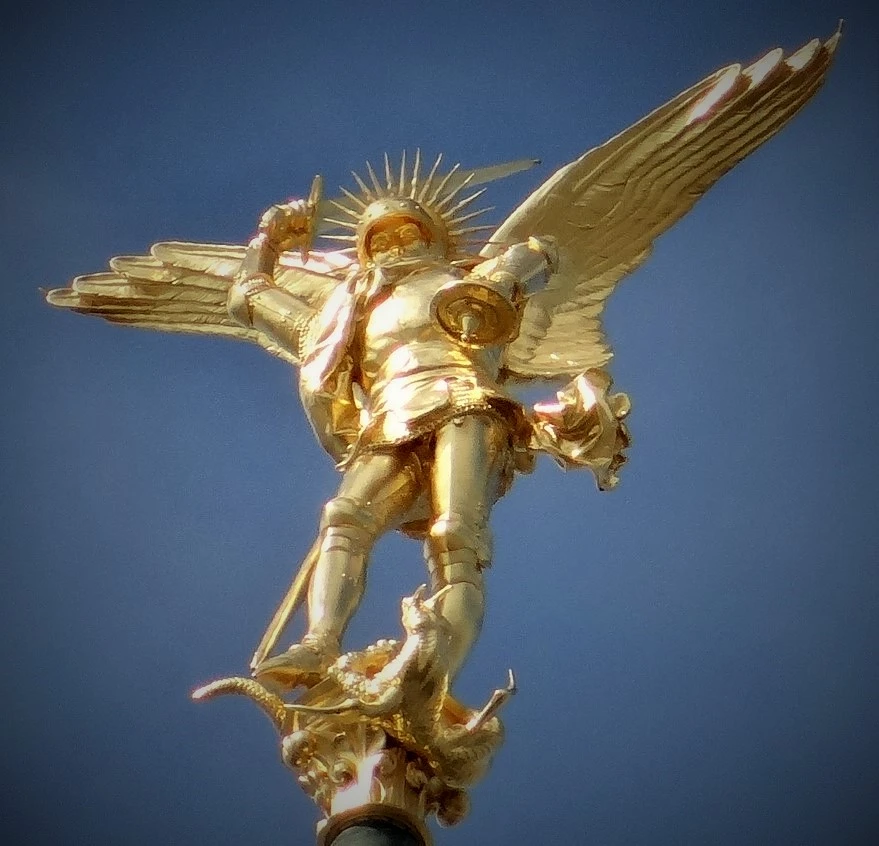
The archangel Saint Michael by Emmanuel FREMIET (1899). He overcomes the dragon which lies at his feet. Photo chosen by Monsieurdefrance.com : Ibex73, CC BY-SA 4.0 <https://creativecommons.org/licenses/by-sa/4.0>, via Wikimedia Commons
The statue, which represents the archangel St. Michael, leader of the heavenly armies, slaying the dragon and crowns the abbey is 4 meters high culminates at 152 meters. It was reinstalled by helicopter during its last renovation. It is signed, Emmanuel Frémiet (1824 - 1910) to whom we also owe the statue of Joan of Arc in Paris near the Louvre. It weighs 520 kg and, beyond the beauty aspect, it has a usefulness is that it serves as a paratonerre
What will you see?
The village
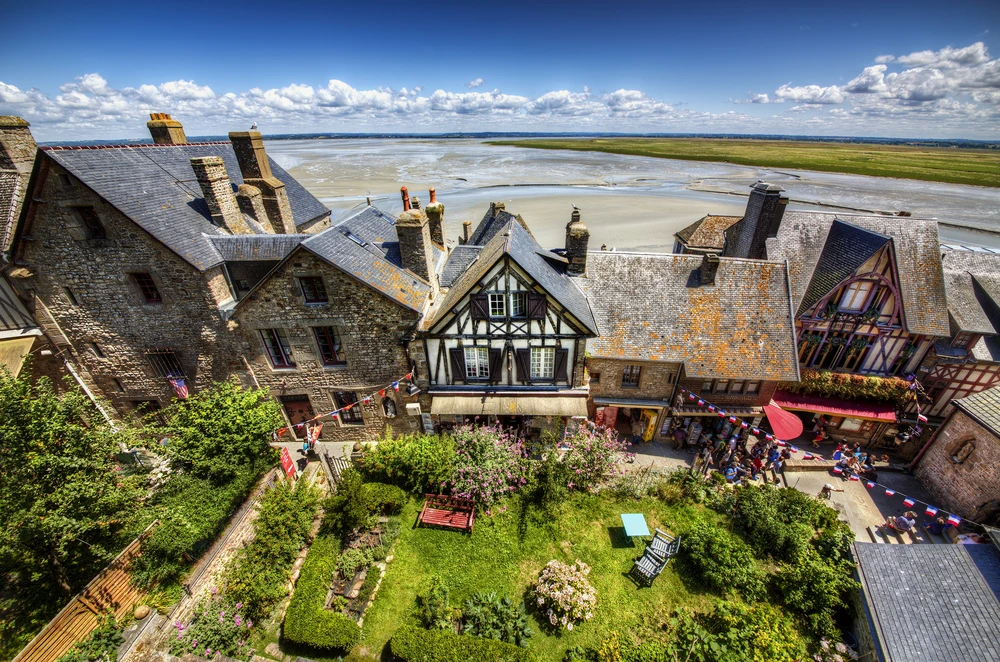
Some houses in Mont Saint Michel. Photo chosen by Monsieurdefrance.com : Rolf E. Staerk/shutterstock
You will arrive in the village by the fortified gate. On the esplanade there are cannons. They were taken from the English in 1431 and are still there. Then you will pass another gate and enter the village. Expect to do a lot of walking and climbing, all the way up to the Abbey. There are a lot of souvenir stores (often from China), but this is a very old tradition since pilgrims in the Middle Ages were already buying souvenirs. There are also museums. Take the small streets, they have charm. You will also discover gardens.
The village church
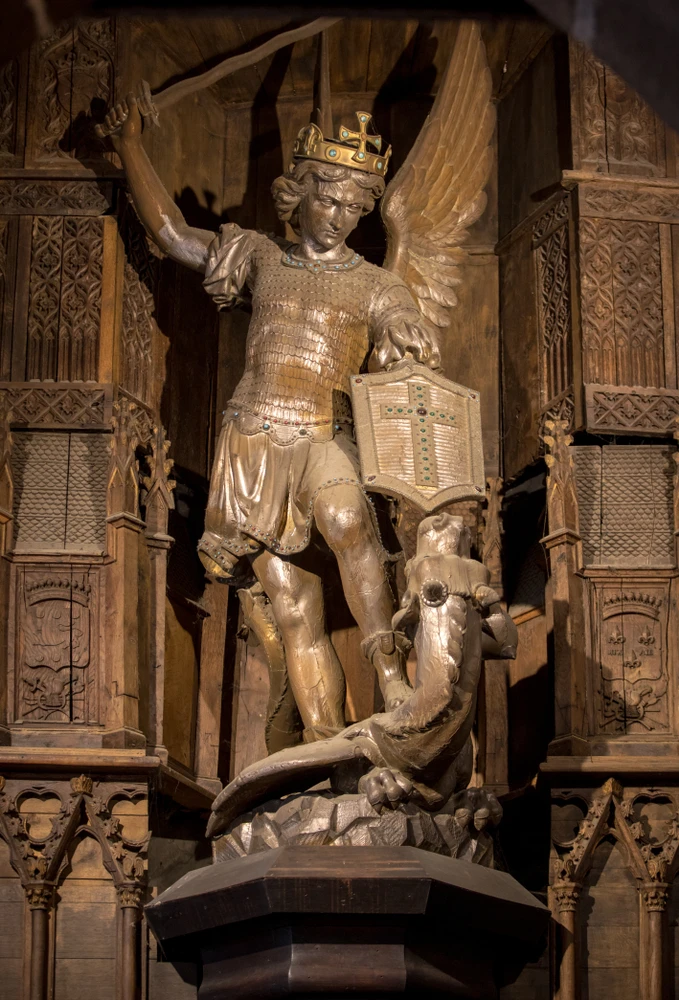
Saint Michael, in the church of the Mont. Photo chosen by Monsieurdefrance.com : wjarek/shutterstock
Located on the left, in the back, when you go up to the abbey. It is called the church of Saint Pierre (patron saint of fishermen, which is logical in the bay) but is largely dedicated to Saint Michel. He is venerated inside. It dates from the 15th and 16th centuries and is next to the small cemetery of Montpellier. The baptismal font is very old (13th century) and a statue of Joan of Arc reminds us that she always claimed that Saint Michael was one of her "voices" that committed her to free France.
The ramparts :
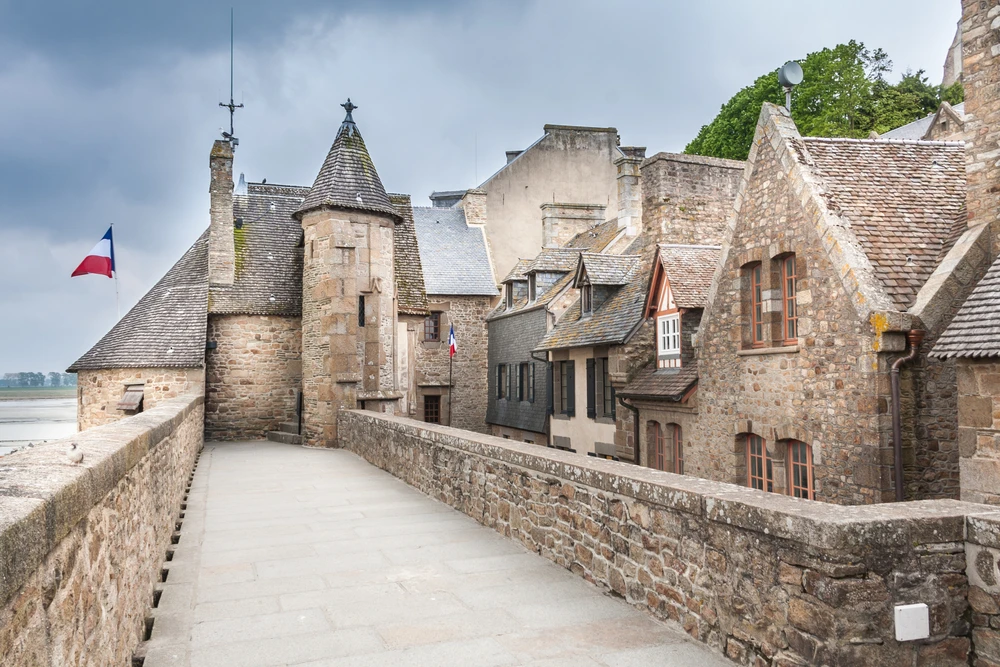
The ramparts of the Mont Saint Michel are accessible Photo chosen by Monsieurdefrance.com : Photomario/shutterstock
They surround the Mont. You don't see them much when you pass by the main street of the village. The best thing to do is to go through them when you come back down from your visit to the Abbey. You will see Normandy in the distance since the village is rather turned towards the East.
The Abbey
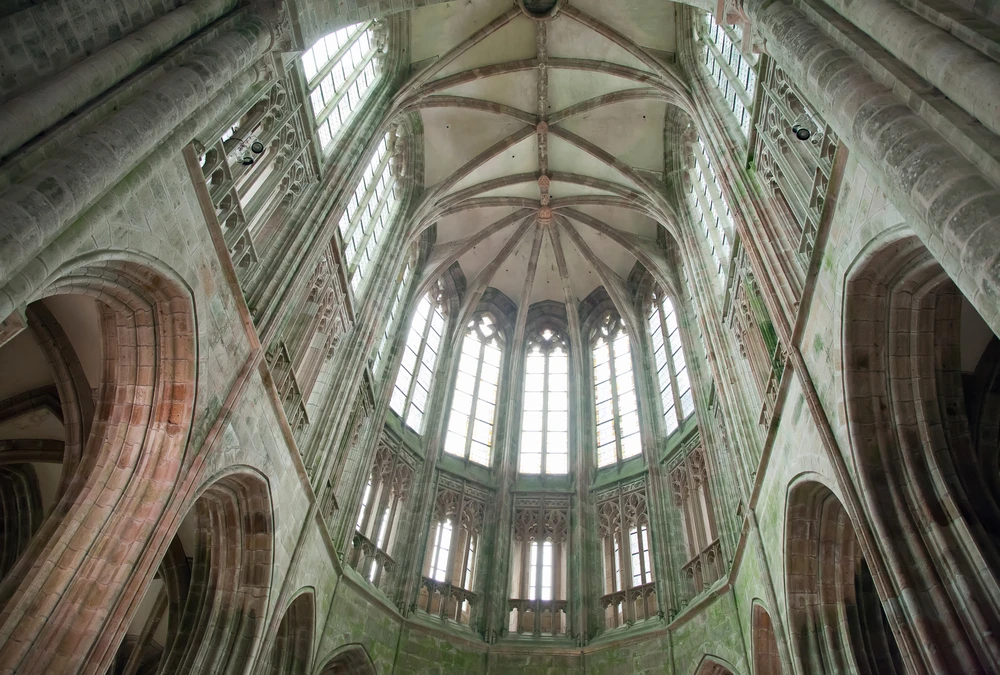
The gothic choir of the abbey of Mont Saint Michel Photo chosen by Monsieurdefrance.com : Daniela Migliorisi/shutterstock
You will arrive by "le Grand Degré" the staircase that leads to "the Hell" the fortified entrance. We say "hell" because it is very dark behind the door. Then you will reach the reception and you will begin the visit by starting with the lowest and thus oldest parts like the crypt of the big pillars. Then you will go up to the refectory, to the scriptorium, to the Knights' room, then you will discover the cloister and you will finish by the Abbey. On the esplanade (which occupies the space of 3 bays that collapsed in the 17th century) you will have a magnificent view of the bay. It is just magical.
Plan at least an hour. It's worth it.
How to visit the Mont Saint Michel ?
The Mont Saint Michel seen from the sky : Photo chosen by monsieurdefrance.com : shutterstock
The best time:
Obviously we are tempted to go there in summer, especially because the weather is better (and when it's very hot, there's nothing more pleasant than a good breeze on top of the Mont). It is always very crowded, especially in July and August and on weekends during the summer. That said, it is capable of swallowing up a lot of people and you will always manage to sneak in.
Best time of day:
That said, we recommend going early in the morning (it's beautiful when it's foggy..) or late in the afternoon (but still allow at least an hour to visit the Abbey in your timing).
The best season of the year:
Spring (March, April, May, June) and fall (September, October, even November... ). But don't hesitate to go in winter. The Mont Saint Michel only takes its real dimension in bad weather, with wind or even rain. It is in these conditions that one understands better what feats were those of the builders and one feels very small at the top of the Abbey.
The high tides:
Watch the coeficients. The higher they are, the more likely you are to see the Mont surrounded by water. From 90/100 you are sure to see it as it is: an island.
Here is the link to know the schedules and the tidal coefficients.
Avoid December 25, January 1 and May 1, these are the only days the Abbey is closed and you can't visit the Mont without seeing the Wonder.
How to get Mont Saint Michel :
Mont Saint Michel is located in the department of Manche in Normandy (and only in Normandy huh!). It is located at 1H from Rennes, 1H15 from Caen, 40 minutes from Saint Malo, 4H30 from Paris by freeway and 5H30 by a mix of freeway and national road. The nearest highway is the A84.
To know : the Mont Saint Michel is a peninsula. It is connected to the coast by a huge footbridge which is nearly 2 kms long. It allows to reach the Mont on foot. You can also go there by crossing the bay, especially from Granville, but BE CAREFUL: never do it alone. You must take a guide. The "lises" (a kind of quicksand) can swallow you up. In the same way that the tide, when it comes back "at the speed of a galloping horse" can trap you and encircle you while you are still far from the Mont. Never take that risk. Others have taken it and never returned.
Mont Saint Michel GPS address
48° 38' 09'' North latitude and 01° 30' 37'' West longitude. But if you type "Mont Saint Michel" on your GPS, it will find it without any problem because the Mont Saint Michel is a commune (which counts 33 inhabitants on 97 hectares) and there is a town hall.
By train / By plane
Note that there is no train station in Mont-Saint-Michel. You can come on foot, by bike, by car or by horse but not by train. The nearest station is in Pontorson. Shuttles allow to reach the Mont. There are also bus routes from Saint Malo or Rennes. Line 308 of the NOMAD line also allows to go from Granville by bus.
In the past, one could go to the Mont Saint Michel by train... It was the beginning of the 20th century / Photo chosen by monsieurdefrance.com Scan by Claude Shoshany - Personal collection, Public domain / Wikipedia
There is a private aerodrome that directly overlooks the bay, in the middle of the salt meadows. It is the aeroclub des grèves du Mont Saint Michel : 55 "bouille", 50 300 Le Val Saint Père. It saw all the same Saint Exupéry passing... The airport of Dinard/Pleurtuit is 40 minutes away, the one of Rennes at 1H15 and the one of Nantes at a little more than 2H.
By car
Type "le Mont Saint Michel" on your GPS. You can try to park for free in Beauvoir (the town preceding the Mont and where there are many stores), but places are rare, especially during the day.
If you continue straight ahead, you will arrive at the parking area. There are 4000 spaces. Park there. It's not cheap but it's the most convenient. If you can, choose P10 or P5 first.
If you are staying at Mont Saint Michel, the P3 parking lot is reserved for you. The hotel will give you a code to enter and you will be given a ticket to keep. Parking P2 is reserved for people with reduced mobility and parking P8 is reserved for motor homes (it is more expensive).
The parking rates vary according to the High Season or Low Season.
For cars: count between 8 and ... 25 euros depending on the season and the duration of the parking.
For motorcycles: count between 5 and 12,50 euros according to the season and the duration of parking.
For camping cars / Motor homes (caution - 8 meters) count between 12 and 27 euros according to the season and the duration of parking.
There is free parking for less than 30 minutes, but no one has ever been able to visit the Mont Saint Michel in 30 minutes...
All information, prices, schedules, map are here.
Always beware of the sand of the bay of the Mont Saint Michel, it has swallowed many unwary people... Photo chosen by Monsieurdefrance Nyokki/shutterstock
Going there by bike
You can leave your bike on the Parking P9, or along the greenway. It is not possible to ride on the footbridge, except from October 1 to April 30.
To get there on foot:
You can leave on foot from the parking lots. It will take you a little more than 40 minutes to walk from the parking lots to the entrance of the Mont. There are other departure points than the parking lots, but you will have to take the footbridge. Never walk alone in the bay from the shore to the Mont.
The shuttles
Because the Mont Saint Michel is quite far from the mainland, there is a shuttle bus system and it is free. It is indicated everywhere on the parking lots but the departure point is almost in the axis of the Mont, near the tourist information center. The bus shuttle is free (it is called the passeur). There is a horse-drawn shuttle called the Marigotte, which is very popular with children and costs 6.70 euros per person (rate 2022). It takes about 25 minutes to arrive at the Mont.
Shuttle bus schedule
The shuttle buses operate between 7:30 a.m. and 11:00 p.m. from March to June and in September-October, from 7:30 a.m. to 1:00 a.m. in July-August, and from 8:30 a.m. to 10:00 p.m. There are night possibilities by calling 02 14 13 20 15
Opening hours of the Mont Saint Michel
The commune of the Mont Saint Michel is accessible 24 hours a day (the village, the ramparts...) On the other hand, the abbey, which is at the top, is not always open.
Opening of the abbey and visits :
From May 1st to August 31st : 9H00 - 19H00
From September 1st to April 30th: 9:00 am - 6:00 pm
Last entrance possible 1 hour before closing time
It is closed on May 1st, December 25th and January 1st.
The Abbey seen from below. Photo chosen by Monsieurdefrance.com : Nick Brundle Photography/Shutterstock.com
Prices and reservation
The individual ticket is 13 euros (in 2024)
It's free for children under 18 years old
It's also free for 18-25 European Union citizens or regular residents of the European Union, for PRMs and an accompanying person outside of groups and finally it's free for the unemployed upon presentation of a certificate of less than 6 months.
Reservation
You can also book your ticket online, it is even recommended, it will avoid you to queue too long at the bottom of the entrance stairs and you can choose morning or afternoon. To book online it is here.
There are guided tours. Without a guide, it takes about 1 hour to discover everything. Audioguides are available.
Our advices :
You are going to walk a lot, foresee good shoes. We go up, we go down, and the slope is often steep. Also, the climate in Normandy is such that you are never safe from a little rain, so bring an umbrella or a hood. Take something to cover yourself with: it is often cool, and it is windy. A wind that comes from the open sea and turns around the Mont and that is quite strong when you are on the esplanade at the top of the "Wonder".
Sleeping at Mont Saint Michel
It is possible. There are hotels all around the Mont, with a view on the Mont. But you can also sleep inside the walls, on the mount. It's even nicer because at night, the Mont Saint Michel is adorned with mysteries. You can for example sleep at the Mouton Blanc or at the Vieille Auberge or at the Saint Pierre hotel or at the Croix Blanche. The establishments are sometimes far from the ultra modern, but it has charm.
A parking lot (P3) is dedicated to people who sleep at the Mont.
Praying at Mont Saint Michel
Mont Saint Michel is always a place of prayer. One can attend masses, vigils... The members of the fraternity come to pick you up at the top of the Grand Degré and you go directly to the abbey to attend the service (you don't pay the entrance fee in this case, but you only have access to the church). The schedule is here.
The Mont Saint Michel is always a place of prayer / Photo chosen by Monsieurdefrance.Com : Jérôme Prod'homme
A secular history
The Mount Tomb
The first known name of the place is the mount "Tombe". No relation with a tomb, but rather a notion of mound or eminence. Some historians affirm that it was a place of druidic worship, but no concrete traces have been found. It is very likely that at the time of the Gauls the Mount was located in the middle of a... Forest! The forest of Scissy, swallowed up by a tidal wave in the early Middle Ages. For a long time held to be far-fetched, this hypothesis of a large forest at this location has been taken a little more seriously in recent years.
Around the 4th century, the first Christians in the area built a chapel dedicated to Saint Etienne halfway up the rock and another to Saint Symphorien at the bottom of the rock. In the 5th century, the cult of Saint Michael began to spread, especially from Italy, the Mount was not yet dedicated to him, but it was predestined since the high places were dedicated to Saint Michael. It is logical, we are closer to the one who is leader of the army of angels.
Who becomes the Mont Saint Michel
It is a bishop who will change everything and make this place one of the most famous of Christianity. According to the legend, in the year 709, the bishop of Avranches, Aubert, received a visit from Saint Michael in a dream. The archangel asked that a sanctuary be built for him on Mont Tombe. More Cartesian than one would imagine for a religious man, the bishop did not believe it and told himself that he had been dreaming. During his third visit, Saint Michael proves that he really came in ... Punching a hole in Aubert's skull with his finger. With the skull pierced, Aubert, who would become Saint Aubert, had no choice but to erect a shrine to Saint Michael on Mont Tombe. For the anecdote, the perforated skull of Aubert, who became "Saint Aubert le marqué" is one of the nails of the show in the treasure of the Cathedral of Avranches.
The dream of Saint Aubert / Archives de la Manche.
The birth of a great abbey
At the beginning, it was a collegiate church that was installed on Mont Tombe, which became Mont-Saint-Michel since the sanctuary was dedicated to Saint Michael, leader of the celestial armies and nicknamed "the soul weigher" because with his scales, the archangel weighed the hearts of the dead. If the heart is heavier than a feather, it is Hell. This role of weigher of souls makes him a saint to whom we often attribute the places of burial, the cemeteries for example.
Saint Michael weighs souls. Cathedral of Coutances (Normandy not far from Mont Saint Michel). Stained glass window of the 15th century on the Last Judgment. Photo chosen by Monsieurdefrance.fr: Selbymay - Personal work, CC BY-SA 3.0, https://commons.wikimedia.org/
Saint Michael is very popular in the West, and very quickly, the sanctuary becomes a very important place of pilgrimage. Pilgrims come from far and wide on the "Montois paths" to get to the Mont, paying their way to experienced guides to avoid the quicksand that can swallow them up (and which you should beware of if you think of walking in the bay) or the tide "coming in at the speed of a galloping horse". At the Mont, they pray in front of the relics: an imprint of Saint Michael's foot in marble, a piece of his red cloak, and even, at one time, a shield and a sword (everything was dispersed during the French Revolution to melt the reliquaries that contained the relics). Having reached their goal, they leave with a souvenir object (already!) sometimes a scallop shell as in Compostela, sometimes a lead or copper medal, which they hang on their hat. These "miquelots", the nickname given to the pilgrims, sometimes transmitted this nickname which became a family name...
Very quickly the Mont Saint Michel became a sanctuary and the object of many pilgrimages. Photo chosen by Monsieurdefrance.Fr : Image by Nbyl from Pixabay
The Abbey grows
A very important sanctuary in the Middle Ages, rich with the donations of the pilgrims who went there, but also with the bequests that were made to it to ensure a place in paradise, the Abbey of Mont Saint Michel became very rich and began major works. Buildings began to be erected according to the habits of the Benedictine monks who definitively founded the abbey in the year 966 with the help of the Duke of Normandy Richard I. They did not build flat as was the case everywhere, but in height. The stones come by boat since the granite is dug on the Chausey islands (you can still see the quarries). The wood comes from the surroundings which are not lacking in wood.
The first church was built over it.

The interior of the Abbey church. The columns on the sides are 1000 years old. The choir, in the background, was built in the 15th century. Photo chosen by Monsieurdefrance.fr: Takashi Images/Shutterstock.com
The first stone church, erected in the year 900, became "Our Lady Underground" when a brand new church, in Romanesque style, was built on top of it. This was a feat at the time, since it was based both on the first Notre Dame church under the ground, which became a foundation, and on the top of the original island, and on new human constructions such as the crypt of the gros-piliers, which was so enormous. The church was built between the year 1023 (the choir) and 1125. For the anecdote, one of the bells of the abbey "Rollon" is there since the construction. The building is 80 meters long and is perched at an altitude of 80 meters.
The walls of the Benedictine abbey seen from the outside (we see the outside of the suspended cloister) Photo chosen by Monsieurdefrance.com : Landscape Nature Photo/Shutterstock.com
It is the beginning of a construction which continues on several centuries, changing according to the errors (it happened that buildings, like the Romanic choir, collapsed.), of the destructions (the Mount knew several fires, in particular storms until the invention of the lightning conductor by Benjamin Franklin in the XVIIIth century.) Nothing stopped the builders who defied the laws of gravity.
The construction of the Wonder
Throughout the Middle Ages, buildings were added or modified. The choir, for example, was rebuilt in 1421 and replaced by the present choir, in the flamboyant Gothic style, which allows light to enter the sanctuary. All around the church, and from the "Grand degré", that is to say the staircase that leads to the abbey, the monks add structures. They installed reception rooms such as the knights' hall, with its enormous chimneys, capable of cooking a whole ox, to welcome the V.I.P. pilgrims (many kings of France or England came here, such as Saint-Louis or Louis XI).
The refectory. One does not see the windows which are on the sides and which are dissimulated by the columns. Photo chosen by Monsieurdefrance.com : Khun Ta/Shutterstock.com
A hostelry is installed, and a system of machines with wooden wheels which allows to hoist more easily the supplies in the cellars of the cellar. The monks' refectory is built, a technical marvel since, if you are at the back, you see it lit without seeing any windows, it is by walking through it that you discover these windows. The highlight is the cloister, suspended above the buildings and adjoining the abbey. Infinitely delicate, its columns form a square in the center of which is an open-air garden conducive to meditation. It is also very symbolic. By raising their buildings higher and higher, the Benedictine monks form a representation of the heavenly Jerusalem described in the Apocalypse.
The suspended cloister of the Mont Saint Michel with its delightful offset columns and its sculptures of acanthus leaves. Photo chosen by Monsieurdefrance.fr: Elena Elisseeva/Shutterstock.com
A powerful intellectual center
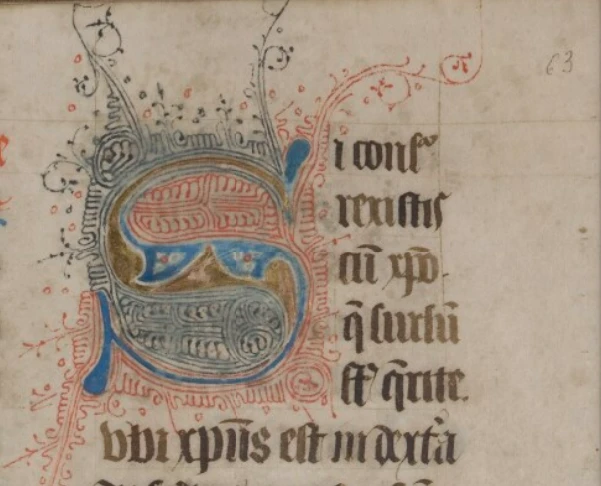
A letter from one of the manuscripts of Mont Saint Michel put online on the virtual library of Mont Saint Michel.
Throughout the Middle Ages, in the scriptorium (which you will visit), one of the only heated rooms (for the agility of the fingers and so that the paint does not freeze in the cups), the monks copied and recopied the knowledge of their time and of previous eras, with a logical predilection for religious documents. They thus produced numerous works which were preserved for a long time at Mont Saint Michel before being moved to Avranches. Some of them were attributed to Saint Lo and were destroyed in 1944 during the bombing of Saint Lo which was 100% destroyed... They can still be consulted online thanks to the Virtual Library of Mont Saint Michel set up by the University of Caen.
A fortress too
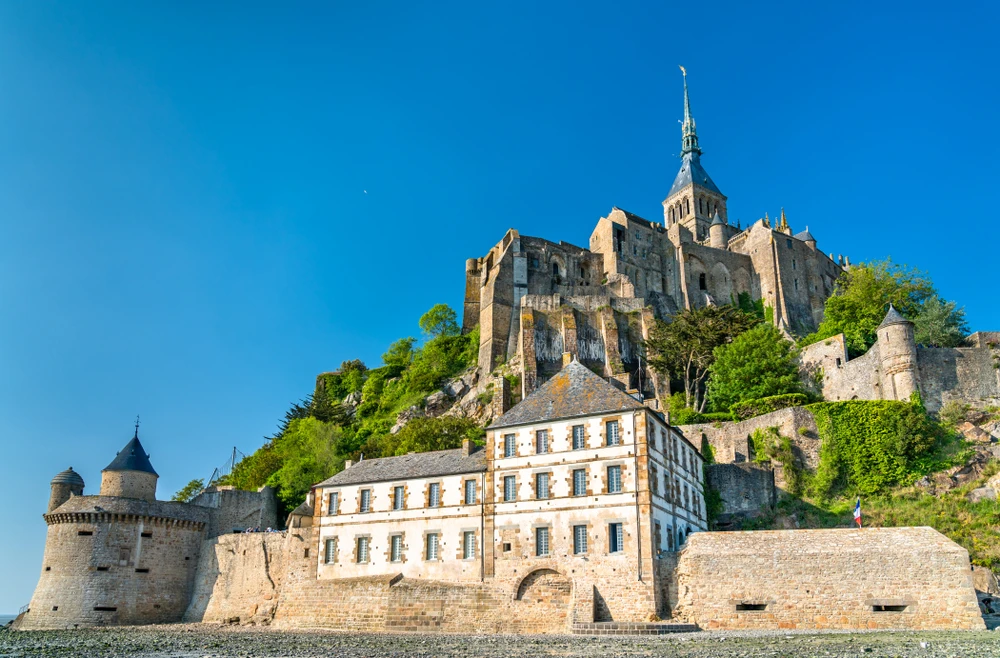
The Mont Saint Michel is also a fortress (impregnable for the English during a siege which lasted 30 years). Photo chosen by Monsieurdefrance.com : Leonid Andronov/Shutterstock.com
The Mont Saint Michel has long been a strategic issue. It is the border of the duchy of Normandy. The dukes therefore fortified it, especially the village which developed at the bottom of the rock, to keep an eye on the neighboring dukes of Brittany. Later on, the kings of France owned the Mont, which meant that it was besieged for 30 years by the English during the 100 years war (which lasted 132 years, but let's not go into that!) It was the time when the towers that you see around the village were built, but also the abbey's defences (notably the Grand Degré). The English led their siege from the Tomblaine island (which you can see in front of the Mont) and succeeded once in taking the village. They never managed to take the abbey. The Mont was also used as a prison for prisoners, which earned it the nickname of "bastille des mers". But this role as a prison was temporary and the abbey remained a religious place for centuries. The French Revolution will change everything...
The "freedom mount" becomes... a gail !
The French Revolution closes the abbey and drives out the monks in 1791. The Mont Saint Michel becomes "freedom mount" and instead of freedom, it is directly given the vocation of a prison. They installed grills between the bays of the church (we can still see the marks, holes in the columns or the walls) and they locked up... Priests. Priests "refractory" because they refused to take the oath to the new constitution which makes them criminals. In the 19th century, common law prisoners were locked up there. Paradoxically, this is what will save the Mont. While many abbeys were sold in France and became stone quarries (such as Jumièges, still in Normandy, in the Seine valley), Mont Saint Michel, a prison, remained as it was, even if it was quite degraded.
The Mont Saint Michel drawn in 1856 by Thomas Drake.
We rediscover the Wonder of the West
At the end of the 19th century, Mont Saint Michel was rediscovered in an era that was also rediscovering the Middle Ages and was passionate about that period. One reads the adventures of Esmerelda in "The Hunchback of Notre Dame" by Victor Hugo (a book that literally saves Notre Dame de Paris by bringing it back to light when it was very damaged). We build in the "neo-gohtic" style to be even better in the air of time. And the Mont Saint Michel, symbol of the Middle Ages, becomes interesting again.
Emmanuel Frémiet (1824-1910), the sculptor of the archangel which now crowns the Mont (what is amusing is that Frémiet was rather a specialist in animals) photo by Adolphe Lalauze (1838-1905)
We begin to see visitors. In 1874 it was classified as a historical monument. In 1878 the road-dike is built (which will be destroyed at the beginning of the XXIst century to leave place, at the price of enormous works, to the current footbridge which lets pass the sea and thus avoids the Mount to be silted up by chasing away the sand accumulated during the tides. The first "tourists" climbed the steps of the village and a tramway was even installed to bring them. The Mount is renovated. It was even improved, for example by the creation, in 1899, of the statue of the Archangel to conceal a lightning rod which finally put an end to fires caused by lightning.
The return of the religious
In 1969, a community of Benedictines returned to the Mont 1000 years after having founded the abbey. It was replaced by a monastic community: the Brotherhood of Jerusalem and became mixed. You will inevitably come across these religious during your visit. The Church, once again consecrated, becomes a place of prayer (which you should not forget when you visit it, remember to do so with respect and silence).
In 1979, the Mont Saint Michel became "World Heritage of Humanity" it is one of the first of a list that is still open and which includes the Wall of China, Venice, the Taj Mahal ... Admit that it deserves it !

